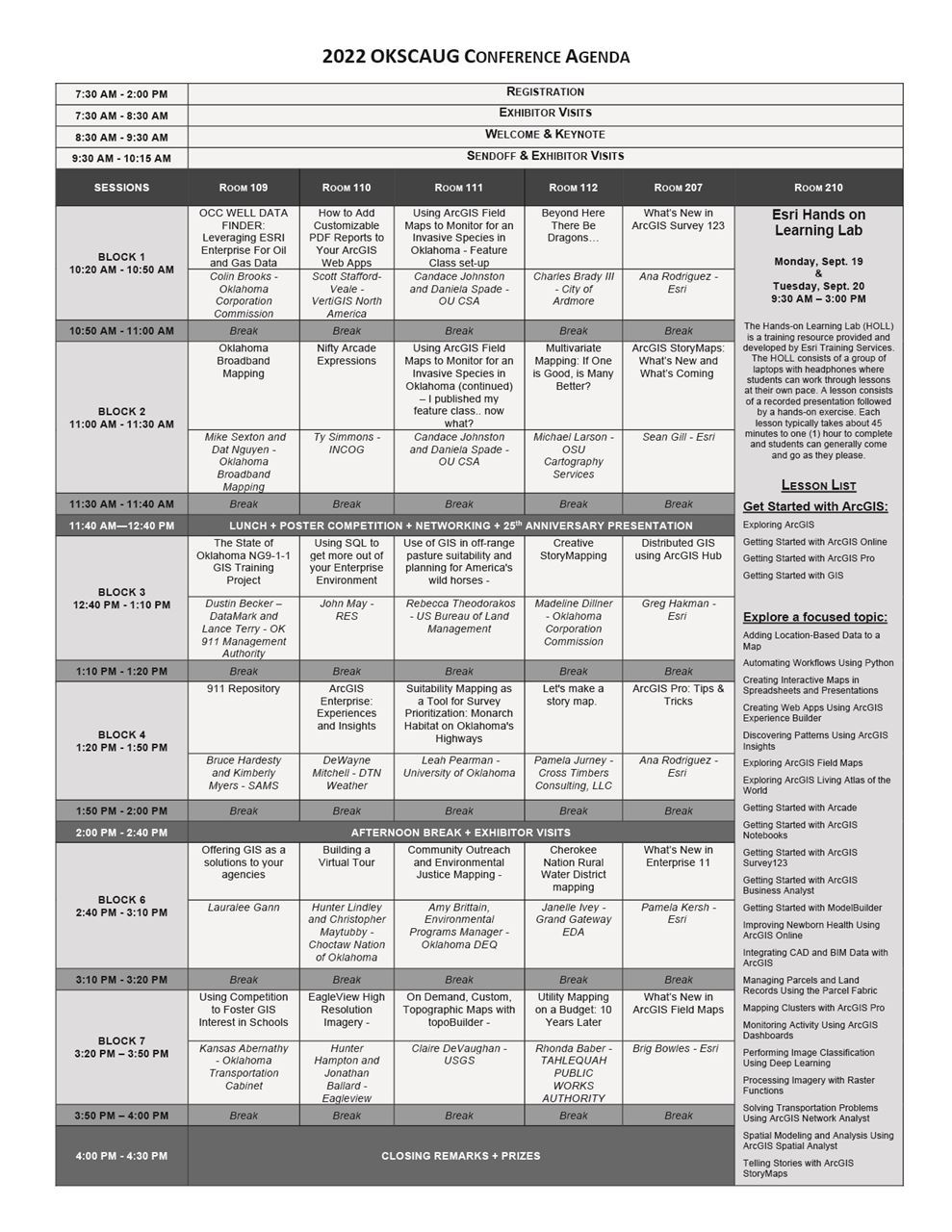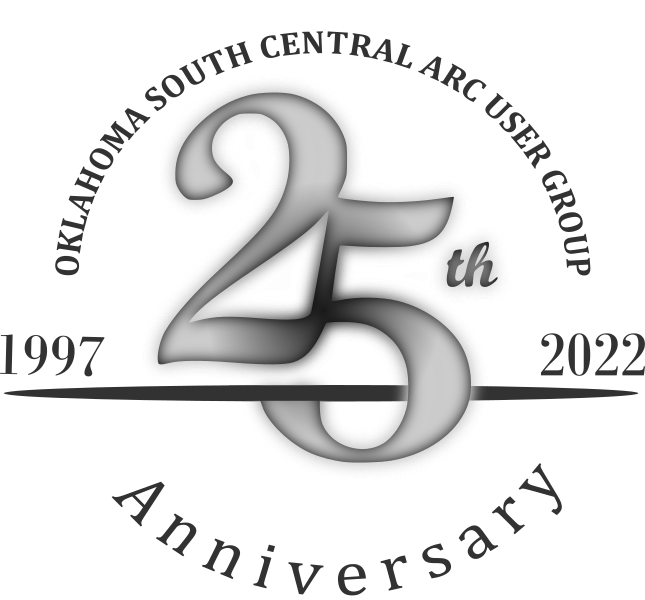
Presentation times can be found in the Conference Agenda and inside the Conference App.


On Demand, Custom, Topographic Maps with topoBuilder Claire DeVaughan, USGS The U.S. Geological Survey’s National Geospatial Program has released the public application topoBuilder, which enables users to create topographic maps on demand using the best available National Map data. In topoBuilder, users can generate topographic maps, called OnDemand Topo, centered anywhere in the United States or Territories, with customized contour smoothing, and export formats GeoTIFF or GeospatialPDF. Maps are made at 1:24,000-scale for the conterminous United States and Hawaii, 1:20,000-scale for U.S. territories, and 1:25,000 for Alaska. Future releases are planned for additional customizations such as user-selected layers, user-added content, GIS data exports, and other map scales. TopoBuilder, its capabilities, and OnDemand Topo maps will be demonstrated. | Madeline Dillner, Brownfield Program Project Coordinator - Oklahoma Corporation Commission How to zhuzh up your StoryMaps to tell your stories, impress your peers, and connect with your audience. The sky's the limit! | Multivariate Mapping: If One is Good, is Many Better? Michael Larson, Manager Geospatial Systems - OSU Cartography Services This short introduction to Multivariate Mapping examines some of the ways we use and visualize multiple variables of statistical data on a single thematic map. We will jump back (way, way, way back) in time to the ever exciting middle 19th century and explore the development of statistical/thematic mapping and look at the early pioneers in data visualization techniques. We will follow their trail and look at examples of visualizing tabular data, single variable (univariate) data, two variable (bivariate) data, and then focus on multiple variable (multivariate) data with examples including, but not necessarily limited to, weather station models and Chernoff faces. |
Cherokee Nation Rural Water District mapping Janelle Ivey, GIS Data Coordinator - Grand Gateway EDA Grand Gateway is leading a project to map all the rural water districts within the Cherokee Nation Reservation. As per the Wilma Mankiller-Charlie Soap Water Act of 2021, this project will provide potable water to every Tribal cardholder in the Cherokee Nation. | Utility Mapping on a Budget: 10 Years Later Rhonda Baber, GIS Mapping Technician / Utility Mapper - TAHLEQUAH PUBLIC WORKS AUTHORITY Ten years ago, I started at TPWA creating a new utility atlas from scratch and with few resources. Today, GIS has moved TPWA into the 21st century. Tahlequah city administration and pubic works are a bit different from more traditional municipalities. I will briefly outline the history, process and current mapping for Public Works in Tahlequah and how GIS has been the medium to get us where we are today. | Using Competition to Foster GIS Interest in Schools Kansas Abernathy, GIS Specialist II - Oklahoma Transportation Cabinet In this presentation, I will speak on the ESRI Web map competition which is facilitated by Oklahoma Transportation Cabinet Information Technology. I will review our previous outreach efforts and new avenues which we are exploring as well as why it is beneficial and important to get children interested in GIS at the middle and high school levels. I’ll outline a few ideas for projects to illustrate how this competition can be incorporated into the curriculum for various subject matters. |
Use of GIS in off-range pasture suitability and planning for America's wild horses Rebecca Theodorakos, Planning & Environmental Specialist - US Bureau of Land Management America’s Wild Horses and Burros are a symbol of the spirit of the American West. The US Bureau of Land Management is responsible for the management of these animals on 26.9 acres of federal lands in ten western states. Populations of horses on BLM lands have been steadily increasing, straining water resources and native plants, and outcompeting local fauna. In an attempt to balance the horse population with the natural ecosystem, excess animals are gathered from rangelands to be shipped to various parts of the country and adopted by local horse enthusiasts and trainers. Unadoptable or older animals are sent to private off-range pastures (primarily in Oklahoma and Kansas) to live out the rest of their lives. This presentation will illustrate how GIS is used for the Off-Range Pasture Program, particularly to determine stocking rate, rotational grazing, cultural resource protection, water resources, and various other issues associated with wild horse management on private lands.
| Using ArcGIS Field Maps to Monitor for an Invasive Species in Oklahoma - Feature Class set-up Candace Johnston, GIS Project Developer and Daniela Spade, and Outreach Coordinator - University of Oklahoma Center for Spatial Analysis CSA demonstrates the workflow required to prepare ArcGIS Field Maps for an invasive species case study in Oklahoma. Demonstration includes creating a hosted feature layer with a related table and domains. ArcGIS Pro and an Enterprise portal are used. | Using ArcGIS Field Maps to Monitor for an Invasive Species in Oklahoma (continued) – I published my feature class.. now what? Daniela Spade, GIS Application and Outreach Coordinator and Candace Johnston, GIS Project Developer - University of Oklahoma Center for Spatial Analysis Do you already know how to configure your feature class for use in ArcGIS Collector and/or Field Maps but are unsure where to go from there?? You are in the right place! This is a continued presentation, but all are welcome. CSA demonstrates how to configure a web map for use in Field Maps. |
Ty Simmons, Principal GIS Analyst - INCOG This presentation will highlight examples of how INCOG has employed Arcade expressions to enhance some of their web maps. The speaker will present examples of how Arcade was used to enhance pop ups without modifying underlying attributes. | Using SQL to get more out of your Enterprise Environment John May, Senior Scientist - RES Enterprise database systems offer a wide range of capabilities.
Unknown to many seasoned practitioners of GIS, there are many operations which
can be performed using SQL within a geodatabase that can streamline and speed
up data management, geoprocessing, and reporting. This presentation will focus
on the use of SQL in SQL Server, Oracle, and Postgresql databases highlighting
data management and visualization techniques. Topics covered will be focused on
using SQL to: | Hunter Lindley, GIS Technician 2 and Christopher Maytubby, UAS Operator - Choctaw Nation of Oklahoma 3D Modeling of interior and exterior spaces is on the rise, and more people than ever have access to user-friendly, low-cost scanners and software. 3D Modeling is used in asset management, construction, film, real estate, interior design, architecture, etc. This presentation will demonstrate the workflow for building an interior and exterior virtual tour using a drone and a 3D scanner for facilities management. We will discuss the drones, scanners, data processing, and presentation software to create a virtual tour. |
Mike Sexton, GIS Manager and Dat Nguyen - Oklahoma Broadband Mapping The Oklahoma Broadband Expansion effort involves many entities across the state from both the public & private sectors. This presentation will discuss the current status of the online map, the wide variety of layers included and the next planned development of the application. | Let's make a story map. Pamela Jurney, Project Manager - Cross Timbers Consulting, LLC Want more of story maps? At the Edmond user group meeting, we explored the making of a story map. For the August user group meeting, we explored the map tour feature in Story Maps. In this presentation, we are going to create a story map. This will be a group guided creation that uses both story map features and AGOL background maps. Come prepared to take a risk in this live, on-the-fly presentation. | The State of Oklahoma NG9-1-1 GIS Training Project Dustin Becker, Business Development Manager – DataMark and Lance Terry, State 911 Coordinator – OK 911 Management Authority Our presentation will be to discuss: The State of Oklahoma has partnered with DATAMARK to offer another round of GIS NG9-1-1 training for 2022. There will be 2 courses offered that will focus on GIS and the Oklahoma NG9-1-1 Standard, the Oklahoma NG9-1-1 GIS Toolkit, and the state GIS repository. We will also be joined by the state to discuss Grant Funding for NG9-1-1 GIS data cleanup projects. |
Community Outreach and Environmental Justice Mapping Amy Brittain, Environmental Programs Manager - Oklahoma DEQ EPA has developed a new Environmental Justice (EJ) mapping and Screening tool called EJScreen. It is based on nationally consistent data an approach that combines environmental and demographic indicators in maps and reports. This session will discuss how you can download and use EPA's EJSCREEN tool and data in your own GIS environment to screen sites based on State specific criteria | Offering GIS as a solutions to your agencies Lauralee Gann Working with Public Service providers to prepare GIS Data for use in different Applications and Software. Updating for NG911 into legacy Systems | Suitability Mapping as a Tool for Survey Prioritization: Monarch Habitat on Oklahoma's Highways Leah Pearman, Graduate Research Assistant - University of Oklahoma The monarch butterfly (Danaus plexippus plexippus), one of the most iconic insects in North America, has experienced massive population declines, due to habitat loss, increased exposure to Conservation of Nature listed the monarch as endangered. The Nationwide Candidate Conservation Agreement of Monarch Butterfly on Energy and Transportation Lands (Monarch CCAA), finalized on April 7, 2020, attempts to mitigate the loss of monarch habitat by enrolling lands managed in the energy and transportation infrastructure. Since the I35 corridor roughly traces the monarch migration route, Oklahoma Department of Transportation (ODOT) Rights-of- Ways (ROWs) were enrolled into the Monarch CCAA, thereby adopting the goals for an annual increase in acreage. However, this created the need to assess the suitability of ODOT’s extensive land holdings for suitable habitat. The objective of this project was to create a data layer of potentially suitable habitat associated with ODOT lands using the Oklahoma Ecological System Map and the ODOT highways shapefile. A binary raster was built from the ~300 ecological systems of suitable or unsuitable habitat. By rasterizing the polyline file and overlaying the binary suitability raster, suitable monarch habitat on ODOT ROWs were identified. A map was then generated for field verification. The results of this verification showed that when filtering the results of this map to include only suitable areas with ROWs greater than <70ft, all sights surveyed were suitable for enrollment into the Monarch CCAA. Given the number of positive occurrences, this data layer will be useful for OKDOT field personnel for managing habitat and not only for the monarch, but also for other species of concern. |
OCC WELL DATA FINDER: Leveraging ESRI Enterprise For Oil and Gas Data Colin Brooks, Regulatory Manager - Oklahoma Corporation Commission The Oil and Gas Conservation Division (OGCD) at the Oklahoma Corporation Commission (OCC) has recently deployed an ESRI Enterprise GIS platform to modernize mapping and spatial data awareness at our Agency. The first project completed in the new platform is OCC’s WELL DATA FINDER application. OCC WELL DATA FINDER was designed and configured with the modular ArcGIS Web AppBuilder interface available in ESRI Enterprise 10.X and 11.0. WELL DATA FINDER replaces the OCC’s legacy GIS data mining website which reached end-of-life in 2022. Contained within the web mapping application are feature layers for much of the public spatial data our Agency and Division curate. Feature Layer data include historical and active well data from our databases, UIC injection/disposal well information and imaging links, geologic and hydrologic data from partner Agencies, and many cultural boundaries for Oklahoma. Much of the data is updated nightly via automatic processes from our production databases. Several pre-configured tools allow well data to be queried and results viewed in the map, distances between points of interest or between well data locations to be measured, and printing user configurable maps of OCC’s Oil and Gas data. Goals of the project were achieved with the creation of a performant web-based mapping application to serve OCC Oil and Gas data to the Public. | Charles Brady III, GIS Coordinator - City of Ardmore We all have probably heard the phrase… “Beyond Here There Be Dragons” Where did it come from and does it even apply now? Throughout the pages of history the cartographer’s maps have not only bore record, but also help shape the future by portraying the past & present. This professional responsibility is said to have carried an ominous warning of danger to the end user. While today’s GIS leverages some of the most technological resources known to mankind, my question is “Have we overcome all the challenges our predecessors faced and slain all their dragons or have our dragons been upgraded as well?” This presentation a unique perspective of some of the common pitfalls mapping professionals still need to be aware of.
| Oklahoma NG9-1-1 toolset & upload to Oklahoma NG911 Data Processing Portal. A real world experience Bruce Hardesty, Business Development Manager, Kimberly Myers, GIS Coordinator - SAM LLC SAM LLC has years of experience preparing PSAP data for NG9-1-1 compliance according to NENA standards and state standards throughout the Midwest. SAM LLC has successfully remediated and uploaded data to the state of Oklahoma’s repository for 11 PSAPs. This presentation will provide a brief overview of preparing the data for submission, using the toolbox and uploading the data to the Oklahoma NG911 Data processing portal. |
EagleView High Resolution Imagery Hunter Hampton, Regional Technical Manager and Jonathan Ballard, District Manager - Eagleview EagleView will present high resolution aerial images, with detail as small as sub-1”, from orthogonal and all four cardinal directions with every feature and landmark photographed from multiple directions. The images are digital and are linked to a computer-based map of the entire surveyed area (with each pixel have x, y, and z values) to enable z-values for vertical measurement and elevation tools. This presentation examines the varied uses of EagleView and its application in the GIS services, Assessment Offices, 911 operators and for field officers showing a profitable investment because the cost and use can be shared over multiple county departments. We will also show how Eagleview imagery can be used in ESRI Products as well as our new 3D Mesh product. | How to Add Customizable PDF Reports to Your ArcGIS Web Apps Scott Stafford-Veale, Account Manager - VertiGIS North America VertiGIS Studio Reporting is a unique drag-and-drop GIS report solution designed for Esri web mapping applications. It lets GIS staff design template PDF reports that can be added to ArcGIS web applications including Web AppBuilder and ArcGIS Online. Report contents can include multiple layer attributes, feature maps, asset photos, tabular data, charts, and more. | ArcGIS Enterprise: Experiences and Insights DeWayne Mitchell, Senior GIS Meteorologist - DTN Weather DTN routinely provides comprehensive weather insights and intelligence to a variety of industries worldwide for the purpose of reducing risk from hazardous weather, thus protecting people and assets. One way DTN conveys weather information and intelligence is through ESRI's ArcGIS (AG) Enterprise comprising but not limited to the following components: AG Server, Portal, the AG Data Store and the AG Web Adaptor and entirely hosted in the Amazon cloud (AWS). Through ArcGIS Enterprise, DTN is able to provide a diverse array of rapidly updating, real-time weather datasets including but not limited to weather radar, lightning, surface weather observations and rainfall accumulation. Each weather dataset is hosted as a web layer/service which is easily consumed, visualized and analyzed using ESRI applications such as ArcGIS Pro and out-of-the-box ESRI web applications. We will describe DTN's deployment of AG Enterprise, the challenges of administering it within AWS and lessons learned. |

